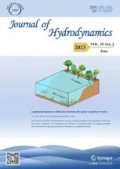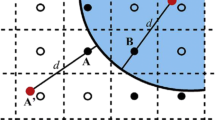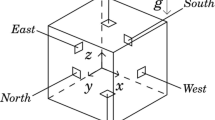Abstract
A thermal-hydrodynamic coupling model is used to investigate the interplay between the wall temperature distribution and the bubble departure during the nucleate boiling process. The boiling process is modeled as the combination of three subprocesses: the transient heat conduction process in the solid heater, the evaporation of the microlayer underneath the bubble, and the bubble dynamics in the two-phase bulk fluid region. The moving bubble interface is captured by the volume of fluid method in the OpenFOAM framework. The proposed model is validated against the experimental results of the boiling process of the water on an Indium Tin Oxide heater. The predicted results agree well with related measurements in the literature. Following the validation, the effects of the boiling heat flux on the bubble departure period are examined. The results show that the bubble departure period decreases with the increase of the applied heat flux. High heat flux will cause irregularity in the departure periods for successive bubbles due to the influence of the wake flow evoked by the rising bubble. Furthermore, the influence of the bubble contact angle on the boiling heat-transfer performance is investigated. It is confirmed that the bubble departure diameter increases with the increase of the contact angle, meanwhile, the average wall temperature decreases with the increase of the contact angle.
Similar content being viewed by others
References
Bertossi R., Caney N., Gruss J. A. et al. Pool boiling enhancement using switchable polymers coating [J]. Applied Thermal Engineering, 2015, 77(5): 121–126.
Zhang L., Wang T., Kim S. et al. The effects of wall superheat and surface wettability on nucleation site interactions during boiling [J]. International Journal of Heat and Mass Transfer, 2020, 146(7): 118820.
Hutter C., Sefiane K., Karayiannis T. G. et al. Nucleation site interaction between artificial cavities during nucleate pool boiling on silicon with integrated micro-heater and temperature micro-sensors [J]. International Journal of Heat and Mass Transfer, 2012, 55(11-12): 2769–2778.
Dzienis P., Mosdorf R., Wyszkowski T. Nonlinear dynamics of self-organising bubble departures from twin nozzles [J]. Meccanica, 2019, 54(14): 2119–2130.
Mosdorf R., Shoji M. Hydrodynamic aspects of interaction between nucleation sites [J]. International Journal of Heat and Mass Transfer, 2008, 51(13-14): 3378–3386.
Ma D., Liu M., Zu Y. et al. Two-dimensional volume of fluid simulation studies on single bubble formation and dynamics in bubble columns [J]. Chemical Engineering Science, 2012, 72: 61–77.
Wang S. P., Zhang A. M., Liu Y. L. et al. Bubble dynamics and its applications [J]. Journal of Hydrodynamics, 2018, 30(6): 975–991.
Abbassi W., Besbes S., Elhajem M. et al. Numerical simulation of free ascension and coaxial coalescence of air bubbles using the volume of fluid method (VOF) [J]. Computers and Fluids, 2018, 161: 47–59.
Zhang Y., Liu M., Xu Y. et al. Three-dimensional volume of fluid simulations on bubble formation and dynamics in bubble columns [J]. Chemical Engineering Science, 2012, 73: 55–78.
Chen X., Chen N., Delgado A. Numerical study of formation of a series of bubbles at a submerged orifice [J]. Applied Mathematical Modelling, 2019, 73(9): 668–694.
Yu X. X., Wang Y. W., Huang C. G. et al. Numerical simulation of bubble detachment at submerged orifice and analysis of interface stability [J]. Journal of Hydrodynamics, 2019, 31(2): 293–302.
Pan F., He Y., Tang Y. L. A multi-scale numerical study on the influence of surface roughness on high-flux nucleate boiling [J]. Journal of Engineering Thermophysics, 2016, 37(11): 2397–2408(in Chinese).
Sanna A., Hutter C., Kenning D. B. R. et al. Numerical investigation of nucleate boiling heat transfer on thin substrates [J]. International Journal of Heat and Mass Transfer, 2014, 76(6): 45–64.
Feng Y., Li H. X., Guo K. K. et al. Numerical study of single bubble growth on and departure from a horizontal superheated wall by three-dimensional lattice Boltzmann method [J]. Microgravity Science and Technology, 2018, 30(6): 761–773.
Cheng P., Zhang C., Gong S. Lattice Boltzmann simulations of macro/microscale effects on saturated pool boiling curves for heated horizontal surfaces [J]. Journal of Heat Transfer, 2017, 139(11): 110801.
Kunkelmann C., Stephan P. CFD simulation of boiling flows using the volume-of-fluid method within OpenFOAM [J]. Numerical Heat Transfer, Part A: Applications, 2009, 56(8): 631–646.
Aktinol E., Dhir V. K. Numerical simulation of nucleate boiling phenomenon coupled with thermal response of the solid [J]. Microgravity Science and Technology, 2012, 24(4): 255–265.
Zhang L., Li Z., Li K. et al. Influence of heater thermal capacity on bubble dynamics and heat transfer in nucleate pool boiling [J]. Applied Thermal Engineering, 2015, 88(SI): 118–126.
Sato Y., Niceno B. Nucleate pool boiling simulations using the interface tracking method: Boiling regime from discrete bubble to vapor mushroom region [J]. International Journal of Heat and Mass Transfer, 2017, 105: 505–524.
Jung S., Ose Y., Kim H. et al. A comparison study of state-of-the-art experimental and numerical simulation results associated with nucleate boiling of a single bubble [C]. Proceedings of the 15th International Heat Transfer Conference, Kyoto, Japan, 2014.
Jung S., Kim H. An experimental method to simultaneously measure the dynamics and heat transfer associated with a single bubble during nucleate boiling on a horizontal surface [J]. International Journal of Heat and Mass Transfer, 2014, 73(4): 365–375.
Utaka Y., Kashiwabara Y., Ozaki M. Microlayer structure in nucleate boiling of water and Ethanol at atmospheric pressure [J]. International Journal of Heat and Mass Transfer, 2013, 57(1): 222–230.
Tange M., Ito M., Kobayashi K. et al. Heat flux partitioning of pool boiling in a confined space into flow field, liquid film thickness, and rewetting [J]. Thermal Science and Engineering, 2017, 25: 57–64(in Japanese).
Gong S., Ma W., Gu H. An experimental investigation on bubble dynamics and boiling crisis in liquid films [J]. International Journal of Heat and Mass Transfer, 2014, 79: 694–703.
Sato Y., Niceno B. A depletable micro-layer model for nucleate pool boiling [J]. Journal of Computational Physics, 2015, 300: 20–52.
Jiang Y. Y., Osada H., Inagaki M. et al. Dynamic modeling on bubble growth, detachment and heat transfer for hybrid-scheme computations of nucleate boiling [J]. International Journal of Heat and Mass Transfer, 2013, 56(1): 640–652.
Cheng K., Pan F., Wang C. J. et al. Experimental study of bubble coalescence behavior in nucleate boiling at a narrow heating surface [J]. Journal of Engineering Thermophysics, 2019, 40(11): 2622–2631(in Chinese).
Mohanty R. L., Das M. K. A critical review on bubble dynamics parameters influencing boiling heat transfer [J]. Renewable and Sustainable Energy Reviews, 2017, 78: 466–494.
Jiang Y. Y., Osada H., Inagaki M. et al. Wall thermal conductivity effects on nucleation site interaction during boiling: an experimental study [C]. 14th International Heat Transfer Conference, American Society of Mechanical Engineers, Washington DC, USA, 2010, 637–646.
Ji W. T., Zhao P. F., Zhao C. Y. et al. Pool boiling heat transfer of water and nanofluid outside the surface with higher roughness and different wettability [J]. Nanoscale and Microscale Thermophysical Engineering, 2018, 22(4): 296–323.
Author information
Authors and Affiliations
Corresponding author
Additional information
Projects supported by the National Key Research and Development Program of China (Grant No. 2013GB113005B), the the National Natural Science Foundation of China (Grant No. 51976026).
Biography: Feng Pan (1991-), Male, Ph. D. Candidate
Rights and permissions
About this article
Cite this article
Pan, F., Mu, Lz., He, Y. et al. A thermal-hydrodynamic coupling method for simulating the interplay between bubble departure and wall temperature variation in nucleate boiling. J Hydrodyn 33, 243–258 (2021). https://doi.org/10.1007/s42241-021-0025-9
Received:
Revised:
Accepted:
Published:
Issue Date:
DOI: https://doi.org/10.1007/s42241-021-0025-9




